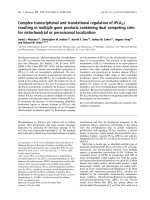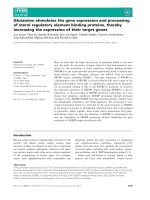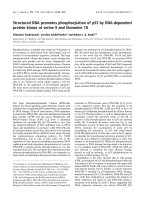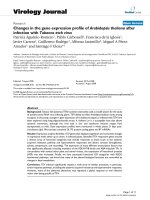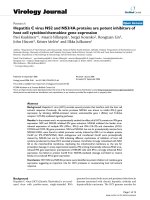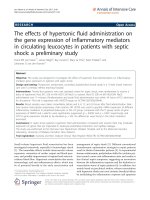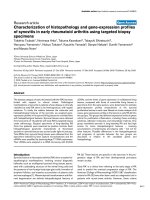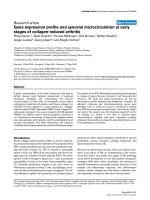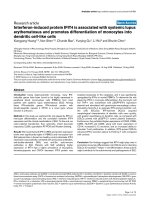OCT4 remodels the phenotype and promotes angiogenesis of HUVECs by changing the gene expression profile
Bạn đang xem bản rút gọn của tài liệu. Xem và tải ngay bản đầy đủ của tài liệu tại đây (691.25 KB, 9 trang )
Int. J. Med. Sci. 2016, Vol. 13
Ivyspring
International Publisher
386
International Journal of Medical Sciences
Research Paper
2016; 13(5): 386-394. doi: 10.7150/ijms.15057
OCT4 Remodels the Phenotype and Promotes
Angiogenesis of HUVECs by Changing the Gene
Expression Profile
Yan Mou1, 3, Zhen Yue1, Xiaotong Wang1, Wenxue Li1, Haiying Zhang1, Yang Wang1, Ronggui Li1 and Xin
Sun2
1.
2.
3.
Key Laboratory of Pathobiology, Ministry of Education, Norman Bethune College of Medicine, Jilin University, Changchun, P.R. China.
Life Science Research Center, Beihua University, Jilin, P.R. China.
The Second Hospital of Jilin University, Changchun, P.R. China.
Corresponding authors: Dr. Ronggui Li, The Key Laboratory of Pathobiology, Ministry of Education, Norman Bethune College of Medicine, Jilin University,
Changchun, 130021, P.R. China. Tel.: 86-431 85619481; Fax: 86-431-85619469; E-mail: and Dr. Xin Sun, Life Science Research Center, Beihua
University, Jilin, 132013, P.R. China. Tel.: 86-432-64608351; E-mail:
© Ivyspring International Publisher. Reproduction is permitted for personal, noncommercial use, provided that the article is in whole, unmodified, and properly cited. See
for terms and conditions.
Received: 2016.01.23; Accepted: 2016.04.12; Published: 2016.04.29
Abstract
It has been shown that forced expression of four mouse stem cell factors (OCT4, Sox2, Klf4, and
c-Myc) changed the phenotype of rat endothelial cells to vascular progenitor cells. The present
study aimed to explore whether the expression of OCT4 alone might change the phenotype of
human umbilical vein endothelial cells (HUVECs) to endothelial progenitor cells and, if so, to
examine the possible mechanism involved. A Matrigel-based in vitro angiogenesis assay was used to
evaluate the angiogenesis of the cells; the gene expression profile was analyzed by an
oligonucleotide probe-based gene array chip and validated by RT-QPCR. The cellular functions of
the mRNAs altered by OCT4 were analyzed with Gene Ontology. We found that induced ectopic
expression of mouse OCT4 in HUVECs significantly enhanced angiogenesis of the cells, broadly
changed the gene expression profile and particularly increased the expression of CD133, CD34,
and VEGFR2 (KDR) which are characteristic marker molecules for endothelial progenitor cells
(EPCs). Furthermore by analyzing the cellular functions that were targeted by the mRNAs altered
by OCT4 we found that stem cell maintenance and cell differentiation were among the top
functional response targeted by up-regulated and down-regulated mRNAs upon forced expression
of OCT4. These results support the argument that OCT4 remodels the phenotype of HUVECs
from endothelial cells to EPCs by up-regulating the genes responsible for stem cell maintenance
and down-regulating the genes for cell differentiation.
Key words: Endothelial Progenitor Cells; Human Umbilical Vein Endothelial Cells; Angiogenesis; Gene
Expression; Octamer-binding transcription factor 4.
Introduction
Studies have shown that in adult bone marrow
and circulating blood there is a population of cells
similar to embryonic angioblasts, known as
endothelial progenitor cells (EPCs). These cells are
types of stem/progenitor cells with the potential to
differentiate into mature endothelial cells and to settle
among injured vascular endothelial cells in order to
repair damaged blood vessels. In humans, EPCs have
been characterized as CD133, CD34, and VEGFR2
(KDR) positive cells [1-4].
The identification of EPCs in adult bone marrow
and circulating blood, revised the dogma on adult
vascularization from one in which angiogenesis was
the only process active in adult vascularization. This
earlier concept speculates that circulating endothelial
cells (CECs) which had emerged from existing
endothelial structures contribute to formation of
distant vascular structures. A newer construct
Int. J. Med. Sci. 2016, Vol. 13
proposes that this process, now identified as postnatal
vasculogenesis, is a type of adult neovascularization,
dependent on bone marrow derived EPCs [1, 5]. In
contrast with endothelial cells, EPCs have a much
stronger ability to proliferate and to contribute to
angiogenesis [6, 7]. Accumulated evidence has shown
the importance of EPCs for neovascluraization and
vascular remodeling [8, 9]. EPCs have been used in
the treatment of vascular diseases [10], promoting
reconstruction of ischemic region [11], and have
recently played an important role in regeneration
medicine [12, 13]. Nonetheless, the limited availability
of EPCs is still a bottle neck that restricts their broad
application in regenerative medicine.
One of the important potential sources of EPCs is
from the differentiation of embryonic stem cells.
Studies have demonstrated that endothelial cells
(ECs) and smooth muscle cells (SMCs) are both
separate cell lineages derived from human embryonic
stem cells [14-16]. Human embryonic stem
cell-derived EPCs and smooth muscle progenitor cells
(SMPCs) are capable of endothelial and smooth
muscle cell function. This research has defined the
developmental origin and revealed the relationship
between these two cell types and provides a complete
biological characterization. The discovery that forced
expression of the four transcription factors OCT4,
Sox2, Klf4, and c-Myc is sufficient to confer a
pluripotent state upon the murine and human
fibroblast genome, generating induced pluripotent
stem cells (iPSCs). These cells have properties similar
to embryonic stem cells (ESCs) with regard to their
multilineage differentiation potential in vitro and in
vivo [17, 18]. The discovery of iPSCs resolved the
ethical issues which has plagued the application of
ESCs in regenerative medicine. Since then, the rapid
progress has been made in the studies on the ways to
generate iPSCs from various somatic cells with the
defined factors, including skin fibroblasts [18, 19],
keratinocytes [20], endothelial cells [21], and blood
progenitor cells [22]. For example, Yin L. et al by
partially reprogramming rat endothelial cells with the
same four transcription factors originally described by
Yamanaka [17] forced their expression in rat aorta
endothelial cells to successfully generate induced
vascular progenitor cells (iVPCs) [23]. These cells
remained committed to vascular lineage and could
differentiate into vascular ECs and vascular smooth
muscle cells (VSMCs) via EPCs and SMPCs in vitro
[23]. These cells were demonstrated better in vitro
angiogenic potential than native ECs [23].
To decrease the risk of teratoma formation, great
efforts have been made to generate iPSCs by
decreasing the number of factors used. In this respect,
octamer binding transcription factor 4 (OCT4), also
387
known as POU domain, class 5, transcription factor 1
(POU5F1) alone has been successfully used to
generate iPSCs from human fetal neural stem cell [24].
OCT4 has also been found to be essential for the
maintenance stem-ness of embryonic stem cells [25]
and its expression is normally confined to pluripotent
cells of embryos [26]. However, research on whether
OCT4 alone might induce human EPCs from ECs has
not been reported. Based on the evidence described
above the present studies were carried out to explore
whether forced expression of OCT4 might generate
EPCs from HUVECs and, if so, to elucidate the
possible mechanism involved.
Materials and Methods
Materials
HUVECs and endothelial cell medium (ECM)
were from the ScienCell Research Laboratories (San
Diego, USA). Doxycycline (DOX) was purchased from
Sigma (St. Louis, USA). Fetal bovine serum (FBS) was
from HyClone Inc. (Logan, USA). The Lentiviral
Packaging Kit was purchased from Biowit Tech.
(Shenzhen, China). The plasmids FUW-M2rtTA and
TetO-FUW-OCT4 were from Addgene (Cambridge,
USA). In Vitro Angiogenesis Assay Kit was from
Millipore (Billerica, USA). Calcein-AM was purchased
from Santa Cruz Biotechnology, Inc. (Dallas, USA).
PCR primers were synthesized from Sangon Biotec.
(Shanghai, China). Trizol Reagent, RT-reaction Kit,
and SYBR® Green PCR Master Mix were purchased
from TaKaRa Biotec. (Dalian, China).
Cell culture and treatments
The HUVECs were grown in ECM medium
containing 5% FBS and 1% endothelial cell growth
supplement (ECGS) at 37°C in 5% CO2 and humidified
atmosphere. Cells were used for all experiments at
passages 2 to 6. For OCT4 induction, the cells were
plated in dishes of a 6 cm diameter at a density of 0.5
× 106 cells per dish. After incubating them for 24
hours, the medium was exchanged with fresh
medium containing DOX (2 µg/ml) or vehicle and
was changed every other day until 7 days when all the
cells were harvested.
Transduction of HUVECs
The
plasmids
FUW-M2rtTA
and
TetO-FUW-OCT4 were purified with an Endo-Free
Plasmid Mini Kit (OMEGA, Norcross, USA). The
pseudo-virus packaging was performed by using
lentiviral packaging kit according to manufacturer’s
instruction in 293-T cells. The supernatants were
collected at 48h and 72h after transfection and the
pseudo-virus were concentrated by high-speed
centrifugation (50000g for 2 hour at 4°C). HUVECs
Int. J. Med. Sci. 2016, Vol. 13
388
were transduced by using the pseudo-virus and
polybrene (4μg/ml) for 24 hours. The medium was
changed on the second day.
RNA purification and RT-QPCR
Total RNA from the cells was purified with a
TRIzol Reagent following the manufacturer’s
instruction. The purity and quantity of the RNA was
measured with spectrophotometer and the quality of
RNA was further monitored by agarose gel
electrophoresis. After treatment with RNase-free
DNase I, RNA was subjected to reverse transcription
with a RT-reaction Kit. The cDNA product was
amplified and quantified with 7300 Real-time PCR
system (Applied Biosystems) in a 25 μl reaction
volume using SYBR® Green PCR Master Mix. The
primer sets used for PCR amplification are shown in
Table 1. The thermal cycling program consisted of 2
min at 50°C, 10 min at 95°C, followed by 40 cycles for
15 sec at 95°C and 1 min at 60°C. After amplification, a
melting curve was generated and data analysis was
performed by using Dissociation Curves 1.0 software
(Applied Biosystems). The normalized value was
given by the ratio of mRNA of the target gene to
mRNA of the reference gene (RPL13A) in each
sample. Fold activation was given by the ratio of the
normalized values of the cells incubated with (+DOX)
Table 1. Primer sets used for RT-QPCR.
Gene
hRPL13A
Primer sets
Forward
Reverse
mOCT4
Forward
Reverse
hOCT4
Forward
Reverse
hKDR
Forward
Reverse
hCD34
Forward
Reverse
hCD133
Forward
Reverse
hAVIL
Forward
Reverse
hS100A4
Forward
Reverse
hSLC12A3
Forward
Reverse
hS100P
Forward
Reverse
hFOLR1
Forward
Reverse
hIQCF1
Forward
Reverse
hCD31
Forward
Reverse
hVE-Cadherin Forward
Reverse
hvW-Factor
Forward
Reverse
Sequences
5'-CGAGGTTGGCTGGAAGTACC-3'
5'-CTTCTCGGCCTGTTTCCGTAG-3'
5'-CAGCCAGACCACCATCTGTC-3'
5'-GTCTCCGATTTGCATATCTCCTG-3'
5'-GGGAGATTGATAACTGGTGTGTT-3'
5'-GTGTATATCCCAGGGTGATCCTC-3'
5'-GTGATCGGAAATGACACTGGAG-3'
5'-CATGTTGGTCACTAACAGAAGCA-3'
5'-CTACAACACCTAGTACCCTTGGA-3'
5'-GGTGAACACTGTGCTGATTACA-3'
5'-CCTCATGGTTGGAGTTGGAT-3'
5'-TTCCACATTTGCACCAAAGA-3'
5'-ACAACGACCCTGGGATCATTG-3'
5'-GTCGAGAGGATGACGTAGCAG-3'
5'-GATGAGCAACTTGGACAGCAA-3'
5'-CTGGGCTGCTTATCTGGGAAG-3'
5'-CTCCACCAATGGCAAGGTCAA-3'
5'-GGATGTCGTTAATGGGGTCCA-3'
5'-AAGGATGCCGTGGATAAATTGC-3'
5'-ACACGATGAACTCACTGAAGTC-3'
5'-GCTCAGCGGATGACAACACA-3'
5'-CCTGGCCCATGCAATCCTT-3'
5'-CAGCCCCAAAAGACGAAGGAA-3'
5'-GCTCCTAAGGACAAATGGGTTG-3'
5'-AACAGTGTTGACATGAAGAGCC-3'
5'-TGTAAAACAGCACGTCATCCTT-3'
5'-TTGGAACCAGATGCACATTGAT-3'
5'-TCTTGCGACTCACGCTTGAC-3'
5'-CCGATGCAGCCTTTTCGGA-3'
5'-TCCCCAAGATACACGGAGAGG-3'
to that without (–DOX) DOX.
In vitro angiogenesis assay
The angiogenesis of the cells was evaluated by a
Matrigel in vitro angiogenesis assay technique [27, 28].
Briefly, 100μl stock solution of Matrigel was added to
each well in 48-well plates and kept at 37°C for 30 min
in order to form the Matrigel. Cell suspensions
containing 3×104 cells in 100μl of ECM were seeded on
the Matrigel of each well, and incubated for 6 hours.
Then Calcein-AM (0.1 mM) was directly added to
each well for 20 min at 37°C to stain the cells and
imaged under a phase contrast microscope with an
excitation wavelength of 490 nm and an emission
wavelength of 515 nm. For quantification, the values
for the pattern recognition, branch point and total
capillary tube length were determined following the
manufacturer’s guidelines (ECM625; Millipore).
ImageJ software was used in the first instance prior to
double-checking by an independent assessor. 5
random microscopic (×100) fields per well were
included and the data are expressed as Mean±SD of 5
samples.
Gene expression profiling analysis
Whole-genome
expression
arrays
were
performed by using Roche NimbleGen chips
(KangChen,
Shanghai,
China),
an
oligonucleotideprobe-based gene array chip containing 45,033
GenBank
transcripts, which provides a comprehensive
NM_012423
coverage of the whole human genome. Total
RNA from each sample was isolated and
NM_013633
quantified by the NanoDrop ND-1000. The
NM_203289
integrity of RNA was assessed by standard
denaturing agarose gel electrophoresis. Total
NM_002253
RNA was used to synthesize cDNA by reverse
NM_001773
transcription reaction, subsequently, which was
labeled with a NimbleGen one-color DNA
NM_006017
labeling kit, and then Hybridized using
NM_006576
NimbleGen Hybridization System following the
manufacturer’s instruction. The chip was
NM_002961
washed, and scanned with Axon GenePix 4000B.
Following normalization, all files of gene
NM_000339
expression level were imported into Agilent
NM_005980
GeneSpring GX software (version 11.5) for
further analysis. Genes that have values greater
NM_000802
than or equal to lower cut-off: 100.0 were chosen
NM_152397
for differentially expressed gene screening. After
data filtering, scatter plot analysis was
NM_000442
performed to assess gene expression data. The
NM_001795
values of X and Y axes in the Scatter-Plot are the
averaged normalized signal values of each
NM_000552
group (log2 scaled). The green lines are Fold
Change Lines (The default fold change value
Int. J. Med. Sci. 2016, Vol. 13
given was 2.0).
Bioinformatics analysis
Gene Ontology (GO) [29] is a functional analysis
to interrogate the possible functions associated with
the differentially expressed genes. Following data
filtering based on the statistical standard,
differentially expressed genes were included in the
analysis. The p-value denotes the significance of GO
Term enrichment in the differentially expressed gene
list. The lower the p-value, the more significant the
GO term is. FDR stands for the false discovery rate of
the GO item. The lower the FDR value, the less the
false discovery rate of the GO item is [29].
Statistical analysis
All calculations and statistical analyses were
performed by using GraphPad Prism 5.0 software
(San Diego, CA, USA). T test was used to analyze the
significance of any differences between two groups.
The statistical significance was defined as p<0.05.
Results
Induced expression of OCT4 in HUVECs
HUVECs that were lentivirally transduced with
the Tet-on controlled OCT4 expression vector were
incubated in the presence of DOX or vehicle to induce
OCT4 expression in the cells. OCT4 mRNA was
analyzed by RT-QPCR. The results are shown in Fig.
1. OCT4 mRNA was increased by more than 20 fold in
the cells treated with DOX, when compared with the
cells not exposed to DOX. These results indicate that
the cellular model for DOX induced OCT4 expression
was established.
Figure 1. Induced expression of OCT4 in HUVECs by DOX. The mRNAs
were analyzed by RT-QPCR and the amount of OCT4 mRNA was normalized to
internal standard RPL13A mRNA. Relative fold was calculated based on the ratio of
the normalized values of the cells incubated with (+DOX) to that without (–DOX)
DOX. The data are expressed as Mean±SD, N=3, ** P<0.01 versus that of –DOX
cells.
OCT4 enhanced the angiogenesis of HUVECs
Angiogenesis is the major function of vascular
endothelial cells (ECs) and their precursor,
389
endothelial progenitor cells (EPCs), which have a
potential application for cell therapy because they
have a much stronger ability for angiogenesis, when
compared with mature ECs [6, 7]. To determine
whether OCT4 can enhance the angiogenesis of
HUVECs or not, an in vitro angiogenesis assay system
was used to evaluate the changes of in vitro
angiogenesis of the cells, based on the formation of
tubular networks. The angiogenesis assay was
performed for HUVECs which were lentivirally
transduced with the Tet-on controlled OCT4
expression vector and incubated with or without
Tet-on inducer DOX. The results are shown in Fig. 2,
in which A and B are representative microscopic
appearances and C-E where the results are statistically
analyzed. Clearly, more tubular networks were
formed in the cells induced with DOX (+DOX) and a
lower percentage of network formations was found in
un-induced cells (–DOX). These results indicate that
forced expression of OCT4 enhanced angiogenesis of
HUVECs, suggesting that OCT4 might remodel the
phenotype of the cells from ECs to EPCs.
OCT4 altered gene expression profiles in
HUVECs
To
explore the
molecular mechanism,
underlying the finding that forced expression of
OCT4 enhanced angiogenesis of HUVECs, whole
genome expression arrays were carried out in
HUVECs lentivirally transduced with the Tet-on
controlled OCT4 expression vector and incubated in
the presence of DOX or vehicle. The Scatter-Plot
analysis of the changes in the gene expression profile
was made to show the global change of gene
expression profile in HUVECs induced by DOX. This
is shown in Fig. 3. Each point on the scatter plot
represents the expression level of an individual
mRNA, as determined by units of fluorescence
intensity. The values of X and Y axes of each point in
the Scatter-Plot represent the levels of respective
mRNA of the cells treated with (+DOX in Fig. 3) and
without DOX (–DOX in Fig. 3), respectively. The
default fold change value given is 2.0 (within the
range of green lines). The points above the top and
below the bottom green lines represent the genes
whose mRNA changed more than 2 fold between two
groups of cells. The numbers of genes whose
expression was up-regulated were 530 genes over 2
fold, 44 genes over 5 fold and 19 genes over 10 fold. In
contrast, the numbers of genes whose expression was
down-regulated were 502 genes over 2 fold, 68 genes
over 5 fold and 20 genes over 10 folds. The results
indicate that the expression of OCT4 broadly changed
the gene expression profile of HUVECs.
Int. J. Med. Sci. 2016, Vol. 13
390
Figure 2. OCT4 enhanced angiogenesis of HUVECs. The angiogenesis of the cells was evaluated by an in vitro angiogenesis assay kit, as described in the method section.
A and B are representative microscopic photographs of uninduced and induced cells. C, D and E are statistically analyzed results. N=5, *P<0.05 and **P<0.01 versus that of -DOX
cells.
Figure 3. Scatter plot analysis of genes regulated by OCT4 in HUVECs. A scatter chart for the normalized mRNA expression data, determined by using Microarray
analysis, was made to show the general change of gene expression profile in HUVECs induced by DOX. +DOX and -DOX represent the mRNA values in the cells incubated with
and without DOX, respectively. Each point on the scatter plot represents the expression level of an individual mRNA, as determined by units of fluorescence intensity. The
default fold change value given is 2.0 (within the range of green lines). The points above the top and below the bottom green lines represent the mRNAs whose values changed
more than 2 fold between two groups of cells. N=3.
Int. J. Med. Sci. 2016, Vol. 13
391
To focus on the genes whose expression was
extremely altered by OCT4, the 20 most up-regulated
and down-regulated mRNAs were identified and are
shown in Table 2 and Table 3, respectively. Table 2
lists the 20 mRNAs that were most up-regulated by
induction of OCT4 in HUVECs. Most of these mRNAs
were increased by more than 10 fold in magnitude
(with the exception of only one mRNA which was
increased by more than 9 fold). Interestingly, OCT4
mRNAs (POU5F1 in Table 2) and the other three
mRNAs (CD133, CD34, and VEGFR2) were among
them. OCT4 is a transcription factor of stem cells and
maintains the stem-ness of the cells by a series of
complex regulated positive feedback networks.
Increased expression of human OCT4 mRNAs
indicates that the induction of ectopic mouse OCT4
can initiate the transcription of the endogenous
human OCT4 gene, whose transcript is undetectable
in HUVECs. CD133, CD34, and VEGFR2 have been
accepted, as three molecular markers of human EPCs
[1-4]. The results suggest that the forced expression of
OCT4 can remodel the phenotype of HUVECs from
ECs to EPCs. Table 3 lists the 20 mRNAs that were
most down-regulated by OCT4 in HUVECs. Most of
them, with the exception of two mRNAs, were
decreased more than 5 fold in the magnitude.
To validate the alteration of mRNAs by OCT4 in
HUVECs, expression of thirteen of the mRNAs was
further confirmed by RT-QPCR. These were chosen
based on five of the mRNAs which were up-regulated
over tenfold: AVIL (85.2), OCT4 (14.1), KDR (15.8),
CD34 (13.2), CD133 (11.0); and eight of
down-regulated: S100A4 (0.14), SLC12A3 (0.16),
S100P (0.08), FOLR1 (0.11), IQCF1 (0.24), CD31 (0.36),
VE-Cadherin (0.15) and vW-Factor (0.60). These all
demonstrated either more than tenfold changes in
expression or are molecular marker of HUVECs. As
shown in Table 4, all of the 13 mRNAs were analyzed
showed the same pattern of change in expression by
the two techniques. Our results indicate the reliability
of the Microarray results. Particularly, we want to
point out that human OCT4 and three molecular
markers for EPCs, CD133, CD34, and VEGFR2 (KDR),
were among the mRNAs whose expressions were
highly increased upon treatment with DOX
determined by two techniques. The results support
above conclusion that phenotypic remodeling of the
cells from ECs to EPCs might occur by forced
expression of OCT4. The two methods also showed
that the mRNAs CD31, vascular endothelial cadherin
(VE-cadherin)
and
von
Willebrand
Factor
(vW-Factor), which are the molecular markers for
mature endothelial cells, but not expressed in their
progenitor cells, were decreased upon DOX
treatment. This result provided additional evidence to
support our conclusion.
Table 2. Top 20 genes up-regulated by OCT4 in HUVECs.
1
2
3
4
5
6
7
8
9
10
11
12
13
14
15
16
17
18
19
20
Genes
KRT10
AVIL
KRT20
FMN1
EHF
PRND
OTOR
KDR
FLJ46906
GPNMB
POU5F1
CD34
FLJ37464
KCNMA1
RNF36
CLDN11
CD133
HS6ST3
CDH10
SUSD2
Fold Increase
97.0 ± 11.79**
85.2 ± 20.39**
31.0 ± 6.12**
30.5 ± 13.67**
29.9 ± 18.73**
27.2 ± 5.97**
22.4 ± 11.89**
15.9 ± 1.57**
15.5 ± 3.65**
14.2 ± 3.70**
14.1 ± 0.82**
13.2 ± 1.82**
13.0 ± 1.55**
11.7 ± 1.05**
11.4 ± 1.18**
11.0 ± 5.56**
11.0 ± 2.86**
11.0 ± 8.52**
10.3 ± 2.35**
9.3 ± 1.83**
Gene Name
keratin 10 (epidermolytic hyperkeratosis; keratosis palmaris et plantaris)
advillin
keratin 20
formin 1
ets homologous factor
prion protein 2 (dublet)
otoraplin
kinase insert domain receptor (a type III receptor tyrosine kinase)
hypothetical gene supported by AK128874; BC071813
glycoprotein (transmembrane) nmb
POU domain, class 5, transcription factor 1
CD34 molecule
hypothetical protein FLJ37464
potassium large conductance calcium-activated channel, subfamily M, alpha member 1
ring finger protein 36
claudin 11 (oligodendrocyte transmembrane protein)
prominin 1
heparan sulfate 6-O-sulfotransferase 3
cadherin 10, type 2 (T2-cadherin)
sushi domain containing 2
GenBank
NM_000421
NM_006576
NM_019010
BC103692
AF124438
NM_012409
NM_020157
NM_002253
XM_928441
BC011595
Z11898
BX538076
AK094783
NM_002247
NM_080745
BC013577
NM_006017
XM_931159
NM_006727
NM_019601
The mRNAs data (fluorescence) determined by Microarray assay were normalized through the Roche NimbleScan software. Relative fold values were calculated based on
the ratio of the cells incubated with DOX to that without DOX. 20 most up-regulated genes are listed. Each value is the Mean ± SD from triplicate samples. **p<0.01, versus
the –DOX cells.
Int. J. Med. Sci. 2016, Vol. 13
392
Table 3. Top 20 genes down-regulated by OCT4 in HUVECs.
1
2
3
4
5
6
7
8
9
10
11
12
13
14
15
16
17
18
19
20
Genes
LOC645009
GAGE5
S100A4
SLC12A3
S100P
KRTHB1
FRMD3
WISP2
GAGE8
FOLR1
IQCF1
LPAL2
FOLR3
SLC16A6
A2M
DKFZP686
A01247
SNCG
SVEP1
FAM46A
GDA
Fold Decrease
0.04 ± 0.02**
0.14 ± 0.15**
0.14 ± 0.06**
0.16 ± 0.01**
0.08 ± 0.04**
0.05 ± 0.01**
0.19 ± 0.20**
0.08 ± 0.04**
0.10 ± 0.07**
0.11 ± 0.09**
0.24 ± 0.26**
0.10 ± 0.05**
0.38 ± 0.44**
0.17 ± 0.16**
0.10 ± 0.05**
0.06 ± 0.01**
Gene Name
similar to GAGE-4 protein (G antigen 4)
G antigen 5
S100 calcium binding protein A4 (calcium protein, calvasculin, metastasin, murine placental homolog)
solute carrier family 12 (sodium/chloride transporters), member 3
S100 calcium binding protein P
keratin, hair, basic, 1
FERM domain containing 3
WNT1 inducible signaling pathway protein 2
G antigen 8
folate receptor 1 (adult)
IQ motif containing F1
lipoprotein, Lp(a)-like 2
folate receptor 3 (gamma)
solute carrier family 16 (monocarboxylic acid transporters), member 6
alpha-2-macroglobulin
hypothetical protein
GenBank
BC081536
NM_001475
NM_002961
NM_000339
BC006819
NM_002281
AY137774
BC058074
NM_012196
NM_000802
NM_152397
AK125910
U08470
NM_004694
NM_000014
NM_014988
0.12 ± 0.07**
0.14 ± 0.10**
0.13 ± 0.10**
0.13 ± 0.03**
synuclein, gamma (breast cancer-specific protein 1)
sushi, von Willebrand factor type A, EGF and pentraxin domain containing 1
family with sequence similarity 46, member A
guanine deaminase
NM_003087
XM_933024
NM_017633
NM_004293
The mRNAs data (fluorescence) determined by using Microarray assay were normalized through the Roche NimbleScan software. Relative fold expression was calculated
based on the ratio of the cells incubated with DOX to that without DOX. 20 most down-regulated genes are listed. Each value is the Mean ± SD from triplicate samples.
**p<0.01, versus the –DOX cells.
Table 4. Validation of the mRNAs expression by RT-QPCR.
mRNAs
AVIL
OCT4
KDR
CD34
CD133
S100A4
SLC12A3
S100P
FOLR1
IQCF1
CD31
VE-Cadherin
vW-Factor
Folds (+DOX/-DOX)
MicroArray
85.2 ± 20.39**
14.1 ± 0.82**
15.8 ± 1.57**
13.2 ± 1.82**
11.0 ± 2.86**
0.14 ± 0.06**
0.16 ± 0.01**
0.08 ± 0.04**
0.11 ± 0.09**
0.24 ± 0.26**
0.36 ± 0.24**
0.15 ± 0.05**
0.60 ± 0.17**
RT-QPCR
12.2 ± 2.64**
26.4 ± 1.98**
7.9 ± 2.20**
10.8 ± 2.22**
8.1 ± 1.47**
0.14 ± 0.25**
0.23 ± 0.11**
0.08 ± 0.04**
0.11 ± 0.20**
0.12 ± 0.06**
0.12 ± 0.02**
0.27 ± 0.05**
0.37 ± 0.19**
The mRNAs determined by Microarray assay and RT-QPCR were normalized
through the Roche NimbleScan software and by the internal standard RPL13A
mRNA, respectively. Relative fold values in expression were calculated based on
the ratio of the cells incubated in the presence (+DOX ) to that of the cells in the
absence (-DOX ) of DOX. Each value is the Mean ± SD from triplicate samples.
**p<0.01, versus the -DOX cells.
Table 5. Molecular functions of genes regulated by OCT4.
Up-regulated by OCT4
immune response
apoptotic signaling pathway
defense response
response to stress
positive regulation of cellular process
multi-organism process
response to biotic stimulus
stem cell maintenance
multicellular organismal signaling
positive regulation of biological process
Down-regulated by OCT4
response to stimulus
cell differentiation
system development
multicellular organismal development
anatomical structure development
cell adhesion
biological adhesion
cell-cell signaling
locomotion
tissue development
p-value*
1.3379E-06
7.4837E-06
2.0037E-05
2.2132E-05
3.7134E-05
4.0214E-05
4.6818E-05
5.0928E-05
5.7531E-05
6.3142E-05
FDR#
0.00595899
0.007612657
0.044623077
0.010952796
0.015073193
0.198188031
0.443289936
0.443289936
0.458326667
0.015624031
7.1105E-11
2.9436E-09
4.2726E-09
5.6016E-09
6.1858E-08
2.8368E-07
3.1936E-07
5.425E-07
3.9781E-06
1.6513E-05
1.5835E-07
4.15823E-06
4.15823E-06
4.15823E-06
2.41044E-05
8.5696E-05
8.89007E-05
0.000142136
0.000610987
0.002228712
Gene Ontology (GO) analysis was carried out on the differentially expressed
mRNAs determined by Microarray assay to explore their molecular functions.
p-value* stands for the significance testing value of the GO item and FDR# stands
for the false discovery rate of the GO item.
Cellular functions of the mRNAs regulated by
OCT4 in HUVECs
The cellular functions that were targeted by the
mRNAs altered by OCT4 were analyzed with Gene
Ontology (GO) [29]. Interestingly, stem cell
maintenance and cell differentiation were among the
top functions targeted by up-regulated and
down-regulated mRNAs upon OCT4 treatment,
respectively, as shown in Table 5. These results
support the argument that OCT4 remodels the
phenotype of HUVECs from ECs to EPCs via
up-regulating the genes responsible for stem cell
maintenance and down-regulating the genes for cell
differentiation. Other biological categories of
statistical significance targeted by up-regulated
mRNAs upon the expression of OCT4 include the
apoptotic signaling pathway, defense response, and
Int. J. Med. Sci. 2016, Vol. 13
positive regulation of cellular and biological process.
The biological categories targeted by down-regulated
mRNAs include the development related (tissue
development; system development; and anatomical
structure development), cell adhesion and cell-cell
signaling. These results gave an additive evidence to
support the hypothesis that phenotypic remodeling of
the cells from ECs to EPCs might occur by forced
expression of OCT4.
Discussion
The limited availability of qualified EPCs is a
major concern in regenerative medicine. In the
present study, we found that forced expression of
OCT4 in HUVECs significantly enhanced the in vitro
angiogenesis of the cells. It has been reported that
EPCs have much better ability for in vitro angiogenesis
than ECs [6, 7]. Based on the major role of OCT4 in
maintaining stem-ness of embryonic stem cells [25]
and inducing generation of iPSCs from human fetal
neural stem cell [24] these results suggest that OCT4
can remodel the phenotype of HUVECs from ECs to
EPCs.
Gene expression profile determines the
characteristic phenotype and the function of the cells.
In the present study, we found that forced expression
of ectopic mouse OCT4 broadly changed the gene
expression profile of HUVECs. Particularly, it
increased the expression of endogenous human OCT4
gene which is a transcription factor of stem cells and
plays an important role in keeping the stem-ness of
the cells. Its transcript is undetectable in differentiated
HUVECs [30, 31], suggesting that phenotypic
remodeling of the cells from ECs to EPCs might occur
by forced expression of OCT4 alone in HUVECs.
Interestingly, the expression of CD133, CD34, and
VEGFR2 which have been accepted as characteristic
molecular markers for human EPCs [1-4] significantly
increased by the forced expression of OCT4 alone in
the HUVECs. The expression of CD31, VE-cadherin
and vW-Factor, which are the molecular markers for
mature ECs, but not expressed in their progenitor
cells [32, 33], were significantly decreased upon the
expression of OCT4. This result supports the
argument that forced expression of OCT4 alone
remodels the phenotype of HUVECs from ECs to
EPCs.
To explore the molecular mechanism on how the
expression of OCT4 affects angiogenesis of HUVECs,
our special attention has been paid to the genes,
whose upregulation might be involved in
angiogenesis, upregulated by OCT4 found in this
study. In addition VEGFR2 (KDR in Table 2), whose
expression was upregulated about 16 times, the
expression of VEGFA, bFGF, eNOS, IL1B and IL6 was
393
also increased significantly upon forced expression of
OCT4, although they are not among the top 20 genes.
Particularly, VEGFA is among them. It has been
reported that VEGF signalling through VEGFR2 is the
major angiogenic pathway, and blockage of
VEGF/VEGFR2 signalling is the first anti-angiogenic
strategy for cancer therapy [34]. It seems to us that
increased angiogenesis of HUVECs upon OCT4
expression might be attributed to the upregulation of
VEGFA and VEGFR2, although further study is
required for the exact mechanism involved. In our
knowledge, the upregulation of VEGF/VEGFR2 by
OCT4 has not been reported in the cells.
Furthermore, by analyzing the cellular functions
targeted by the altered mRNAs, stem cell
maintenance and cell differentiation were among the
top categories targeted by up-regulated and
down-regulated mRNAs following forced expression
of OCT4. These results further support the argument
that OCT4 can remodel the phenotype of HUVECs
from ECs to EPCs via up-regulating the expression of
genes responsible for stem cell maintenance and
down-regulating the expression of genes for cell
differentiation. The results provide additive evidence
supporting the hypothesis that the forced expression
OCT4 alone in HUVECs might remodel the
phenotypes of the cells from ECs to EPCs by broadly
changing their gene expression profile. Taken
together the results indicate that OCT4 can remodel
the phenotype of HUVECs from ECs to EPCs. To our
knowledge, this study provides the first evidence
indicating that OCT4 alone remodels the phenotype
and promotes angiogenesis of HUVECs by changing
the gene expression profile. Theoretically, these
findings provide more insights on the role of OCT4 in
keeping progenitor state of endothelial cells.
Practically, the present study might provide an
efficient way to generate adequate numbers of
qualified EPCs for regenerative medicine.
Conclusions
In the present study, we found that forced
expression of mouse OCT4 in HUVECs remodels the
phenotype of the cells from ECs to EPCs. This
conclusion was supported by the following evidence:
firstly forced expression of mouse OCT4 enhanced in
vitro angiogenesis of the cells (EPCs have stronger in
vitro angiogenesis ability than ECs); it up-regulated
the expression of CD133, CD34, and VEGFR2 (they
are characteristic molecular markers for human EPCs)
and down-regulated CD31, VE-cadherin and
vW-Factor (they are the molecular markers for mature
ECs, but not expressed in their progenitor cells).
Further by analyzing the cellular functions targeted
by the mRNAs altered upon OCT4 expression we
Int. J. Med. Sci. 2016, Vol. 13
found that functions associated with stem cell
maintenance were targeted by up-regulated mRNAs
and cell differentiation functions were targeted by
down-regulated mRNAs.
Acknowledgments
This study was supported in part by the National
Natural Science Foundation of China (Grants: NSFC
No. 21277057) and National Science Foundation of
Jilin Province (No. 20130624003JC). We would like to
express our great appreciation to Professor F. William
Orr from the University of Manitoba in Canada for his
great help in revising the manuscript and to Professor
Rudolf Jaenisch from the Whitehead Institute for
Biomedical Research in USA for his great help in
contributing the plasmids FUW-M2rtTA and
TetO-FUW-OCT4 to Addgene.
Competing Interests
The authors have declared that no competing
interest exists.
References
1.
2.
3.
4.
5.
6.
7.
8.
9.
10.
11.
12.
13.
14.
15.
16.
Rafii S, Lyden D. Therapeutic stem and progenitor cell transplantation for
organ vascularization and regeneration. Nature medicine. 2003; 9: 702-12.
Iwami Y, Masuda H, Asahara T. Endothelial progenitor cells: past, state of the
art, and future. Journal of cellular and molecular medicine. 2004; 8: 488-97.
Peichev M, Naiyer AJ, Pereira D, Zhu Z, Lane WJ, Williams M, et al.
Expression of VEGFR-2 and AC133 by circulating human CD34(+) cells
identifies a population of functional endothelial precursors. Blood. 2000; 95:
952-8.
Caiado F, Dias S. Endothelial progenitor cells and integrins: adhesive needs.
Fibrogenesis Tissue Repair. 2012; 5.
Asahara T, Murohara T, Sullivan A, Silver M, van der Zee R, Li T, et al.
Isolation of putative progenitor endothelial cells for angiogenesis. Science.
1997; 275: 964-6.
Yoon C-H, Hur J, Park K-W, Kim J-H, Lee C-S, Oh I-Y, et al. Synergistic
neovascularization by mixed transplantation of early endothelial progenitor
cells and late outgrowth endothelial cells the role of angiogenic cytokines and
matrix metalloproteinases. Circulation. 2005; 112: 1618-27.
Sieveking DP, Buckle A, Celermajer DS, Ng MK. Strikingly different
angiogenic properties of endothelial progenitor cell subpopulations: insights
from a novel human angiogenesis assay. Journal of the American College of
Cardiology. 2008; 51: 660-8.
Calzi SL, Neu MB, Shaw LC, Kielczewski JL, Moldovan NI, Grant MB. EPCs
and pathological angiogenesis: when good cells go bad. Microvascular
research. 2010; 79: 207-16.
Hristov M, Weber C. Endothelial progenitor cells in vascular repair and
remodeling. Pharmacological Research. 2008; 58: 148-51.
Schmidt DE, Manca M, Hoefer IE. Circulating endothelial cells in coronary
artery disease and acute coronary syndrome. Trends in cardiovascular
medicine. 2015.
Peplow PV. Growth factor-and cytokine-stimulated endothelial progenitor
cells in post-ischemic cerebral neovascularization. Neural regeneration
research. 2014; 9: 1425.
Foster WS, Suen CM, Stewart DJ. Regenerative cell and tissue-based therapies
for pulmonary arterial hypertension. Canadian Journal of Cardiology. 2014;
30: 1350-60.
Wei L, Zhu W, Xia L, Yang Y, Liu H, Shen J, et al. Therapeutic effect of
eNOS-transfected endothelial progenitor cells on hemodynamic pulmonary
arterial hypertension. Hypertension Research. 2013; 36: 414-21.
Ferreira LS, Gerecht S, Shieh HF, Watson N, Rupnick MA, Dallabrida SM, et al.
Vascular progenitor cells isolated from human embryonic stem cells give rise
to endothelial and smooth muscle–like cells and form vascular networks in
vivo. Circulation research. 2007; 101: 286-94.
Hill KL, Obrtlikova P, Alvarez DF, King JA, Keirstead SA, Allred JR, et al.
Human embryonic stem cell-derived vascular progenitor cells capable of
endothelial and smooth muscle cell function. Exp Hematol. 2010; 38: 246-57 e1.
Glaser DE, Gower RM, Lauer NE, Tam K, Blancas AA, Shih AJ, et al.
Functional characterization of embryonic stem cell-derived endothelial cells. J
Vasc Res. 2011; 48: 415-28.
394
17. Takahashi K, Yamanaka S. Induction of pluripotent stem cells from mouse
embryonic and adult fibroblast cultures by defined factors. cell. 2006; 126:
663-76.
18. Takahashi K, Tanabe K, Ohnuki M, Narita M, Ichisaka T, Tomoda K, et al.
Induction of pluripotent stem cells from adult human fibroblasts by defined
factors. cell. 2007; 131: 861-72.
19. Yu J, Vodyanik MA, Smuga-Otto K, Antosiewicz-Bourget J, Frane JL, Tian S, et
al. Induced pluripotent stem cell lines derived from human somatic cells.
Science. 2007; 318: 1917-20.
20. Aasen T, Raya A, Barrero MJ, Garreta E, Consiglio A, Gonzalez F, et al.
Efficient and rapid generation of induced pluripotent stem cells from human
keratinocytes. Nature biotechnology. 2008; 26: 1276-84.
21. Lagarkova MA, Shutova MV, Bogomazova AN, Vassina EM, Glazov EA,
Zhang P, et al. Induction of pluripotency in human endothelial cells resets
epigenetic profile on genome scale. cell cycle. 2010; 9: 937-46.
22. Loh Y-H, Agarwal S, Park I-H, Urbach A, Huo H, Heffner GC, et al.
Generation of induced pluripotent stem cells from human blood. Blood. 2009;
113: 5476-9.
23. Yin L, Ohanyan V, Pung YF, DeLucia A, Bailey E, Enrick M, et al. Induction of
vascular progenitor cells from endothelial cells stimulates coronary collateral
growth. Circulation research. 2012; 110: 241-52.
24. Kim JB, Greber B, Araúzo-Bravo MJ, Meyer J, Park KI, Zaehres H, et al. Direct
reprogramming of human neural stem cells by OCT4. Nature. 2009; 461:
649-53.
25. Zeineddine D, Hammoud AA, Mortada M, Boeuf H. The Oct4 protein: more
than a magic stemness marker. American journal of stem cells. 2014; 3: 74.
26. Wu G, Schöler HR. Role of Oct4 in the early embryo development. Cell
Regeneration. 2014; 3: 7.
27. Salani D, Taraboletti G, Rosano L, Di Castro V, Borsotti P, Giavazzi R, et al.
Endothelin-1 induces an angiogenic phenotype in cultured endothelial cells
and stimulates neovascularization in vivo. Am J Pathol. 2000; 157: 1703-11.
28. Amini AR, Laurencin CT, Nukavarapu SP. Differential analysis of peripheral
blood- and bone marrow-derived endothelial progenitor cells for enhanced
vascularization in bone tissue engineering. J Orthop Res. 2012;30: 1507-15.
29. Ashburner M, Ball CA, Blake JA, Botstein D, Butler H, Cherry JM, et al. Gene
ontology: tool for the unification of biology. The Gene Ontology Consortium.
Nat Genet. 2000; 25: 25-9.
30. Yu KR, Yang SR, Jung JW, Kim H, Ko K, Han DW, et al. CD49f enhances
multipotency and maintains stemness through the direct regulation of OCT4
and SOX2. Stem cells. 2012; 30: 876-87.
31. Panopoulos AD, Ruiz S, Yi F, Herrerías A, Batchelder EM, Izpisua Belmonte J.
Rapid and highly efficient generation of induced pluripotent stem cells from
human umbilical vein endothelial cells. PloS one. 2011; 6: e19743.
32. Barber CL, Iruela-Arispe ML. The ever-elusive endothelial progenitor cell:
identities, functions and clinical implications. Pediatric research. 2006; 59:
26R-32R.
33. Medina RJ, O'Neill CL, Sweeney M, Guduric-Fuchs J, Gardiner TA, Simpson
DA, et al. Molecular analysis of endothelial progenitor cell (EPC) subtypes
reveals two distinct cell populations with different identities. BMC medical
genomics. 2010; 3: 18.
34. Lohela M, Bry M, Tammela T, Alitalo K. VEGFs and receptors involved in
angiogenesis versus lymphangiogenesis. Curr Opin Cell Biol. 2009; 21: 154-65.
